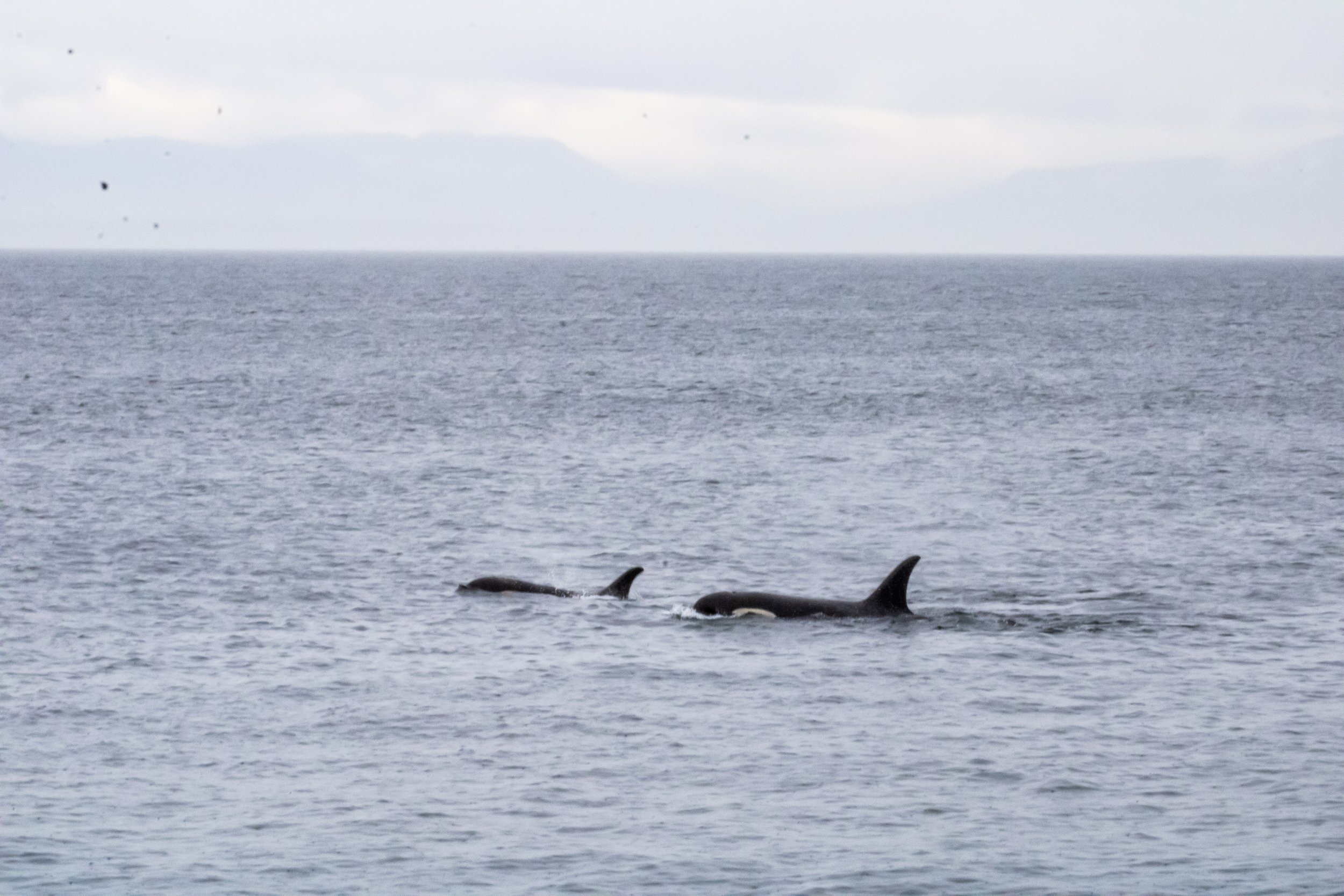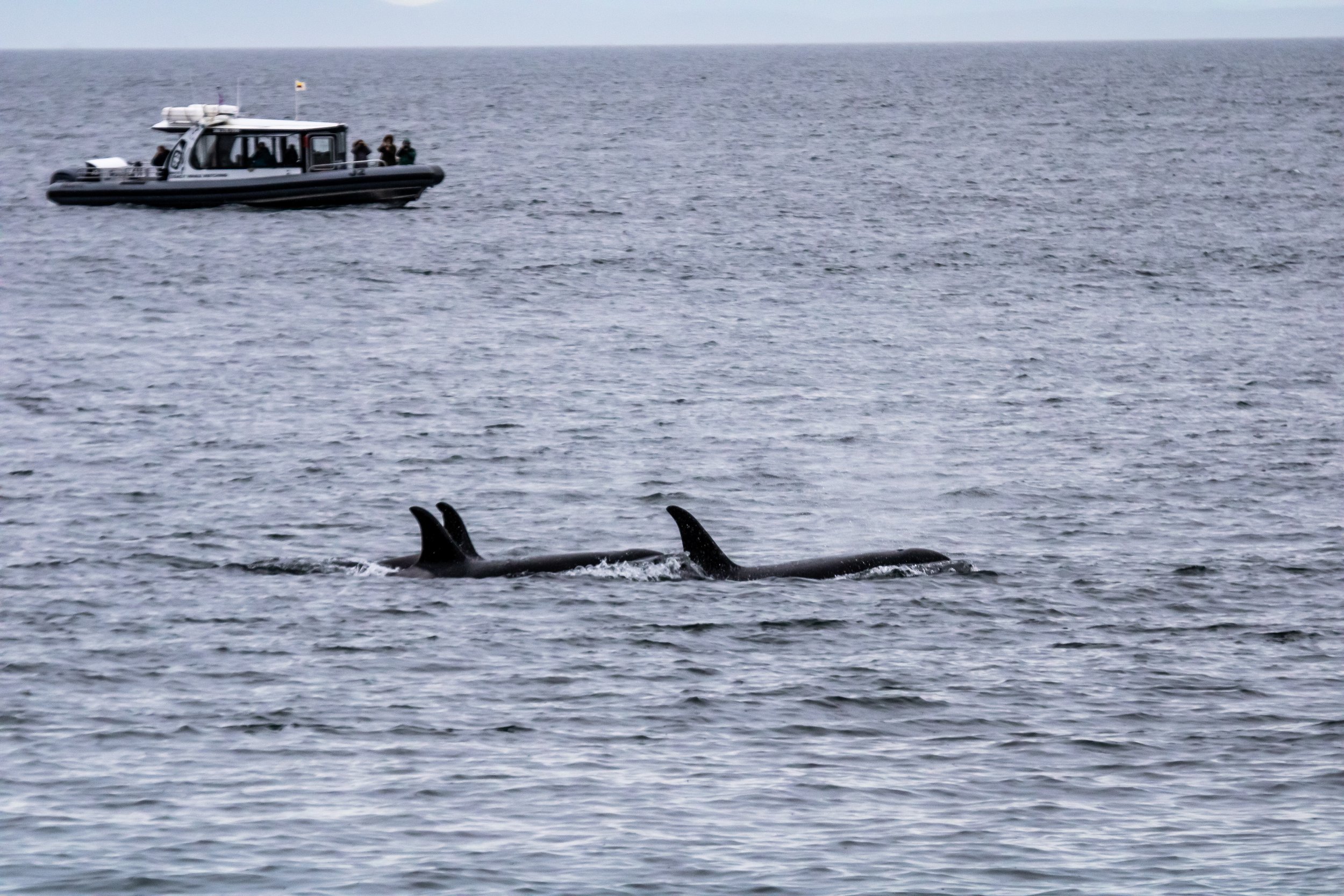February 24, 2024: A5 Pod | Bowen Island, BC
Date: Saturday, February 24, 2024
Location: Bowen Island, British Columbia, Canada
Weather: Rainy, 48 degrees Fahrenheit with 21mph winds from S
Tide: Ebb
Pods: A5 Pod (Northern Resident killer whales)
Total Whale Count: ∼15
Behaviors: Traveling, socializing
Boat Count: 3 (BC Ferry, private vessel, whale watch vessel)
A114 Ashlar, A79 Current, A42 Sonora, & A119 Venture (Photo by Kendra Nelson)
This day was definitely one for the record books! During the preceding week, Northern Resident killer whales were keeping a presence in Howe Sound, just north of Vancouver, British Columbia. When Orca Conservancy Board Secretary Kendra Nelson invited me to stay with her up in Canada so we could look for the Northern Residents during the weekend, I couldn’t pass on the chance to do so. We also invited orca enthusiast and TikTok influencer The Orca Man to join us.
I wasn’t entirely sure if the Northern Residents would still be around by the weekend, so before committing we kept a close watch on a few different sightings groups in Canada, then on the Friday morning before, I made the call to take the trip up and was on my way to Canada. The last reports of the day indicated that the NRKWs went east into Howe Sound, which was promising. Even though they were still in the area, I always kept in the back of my mind that there was the potential that they could leave, and I fully accepted that the following day could just be a sightseeing day and didn’t build the expectation that we would find them.
We all agreed to be out scanning on the water at first daylight in hopes to be the first to find the whales, and we all convened to carpool around 6am where we met up in Vancouver and then headed to Lighthouse Park in West Vancouver. We took the short hike to the water and scanned around for close to an hour with no signs of the whales. We decided to head to the next location taking the Sea-to-Sky highway to Lions Bay to get a different vantage point of Howe Sound. We scanned there for a while and watched a stellar sea lion catch multiple fish, and a couple of other sea lions passed us pretty close checking us out.
We decided to head to the next point, and eager to make it to the Sunshine Coast, I convinced the group to hop a ferry out of Horseshoe Bay. We paid for the ferry and got in line, then went up to the terminal to try and scan. After we parked the car, we got a tip from a friend that a group of killer whales, presumed to be Northern Residents were traveling south down the east side of Bowen Island (located at the center of Howe Sound). This was both good and bad news for us. The good news was that the whales had been spotted and were around, bad news because of the location we were about to travel to we would not be able to see the whales.
Trying to come up with a plan, we decided we would at least go to the ticketing office to ask about the possibility of changing ferries despite the car already being in the ferry line. The employee was more than happy to help us and we were allowed to switch ferries. After refunding the previous ferry and paying for a new ticket to Bowen Island, the employee radioed a person to come escort us out of the ferry line. Fortunately, The Orca Man had the sense to ask the cars filling the lane beside us to leave a gap open for us to back out, and once the employee came to assist us, we made a very interesting backup turn maneuver, backing out of the entirety of the lane, then being redirected to the appropriate lanes to board Bowen Island. As we pulled up they had just finished boarding the ferry and they were about to let us on, but unfortunately for us, they had already lifted the ramp and we had to wait an hour for the next one.
As we were waiting for the next ferry, a second group of orcas was reported on the other side of Bowen Island, giving us a pretty solid opportunity to see orcas. We boarded the ferry and studied the map of Bowen Island while also scanning the water in route. After the latest sighting came through, the first group was off of Seymore Landing on the southeast side of the island. We decided to look for this group as it was yielding the most updates and we felt we had good opportunities to get to locations to view them. We knew we didn’t have time to get to Seymore Landing, and the next publicly accessible viewpoint was Roger Curtis Beach and the lighthouse on the Southwest side.
The drive was a short 15 minutes and when we got there we scanned for a while before a new update came in saying the whales were approaching the Cape traveling east. We were all quite confused because we were at the Cape, and an eastward direction would indicate they were traveling away from us and instead in the direction of Vancouver. We headed to the car to go to the next location, but Kendra wasn’t convinced they were going that way. My gut said to listen to Kendra and this was the right call. Kendra commented and asked the reporter to clarify, and later their post was edited and the mention of an eastward direction was a typo that was changed to west, meaning they were headed right towards us.
After walking around to different viewing locations while waiting, we were all looking to the east for the first group. While looking to the east, Kendra noticed some people on the rocks west of us pointing at the water, and right off the bluff there it was, a dorsal fin coming right towards us. Kendra shouted at me to look over where I saw the distinguishable dorsal fin of A79 submerging into the water. Stumbling to get my camera out of sheer excitement, I began shouting at all the people scattered to the east of us letting them know the second group had quite literally snuck up on us from the other direction. The whales went on a long deep dive for well over 5 minutes, which felt like an eternity, especially after having announced to everyone there were whales right there.
After around 7 minutes the group surfaced immediately in front of us and very close to shore. This group was the A42 matriline with the brand new calf of A79 that was first seen earlier in the month. The whales all surfaced in a group multiple times very close to us giving us incredible looks as well as opportunities to hear their exhales. As they were passing there was a large group of stellar sea lions that kept surfacing right off the bluff looking quite nervous about the approaching orcas. Fortunately for them, the Northern Residents like their Southern Resident cousins are exclusively fish eaters.
Kendra and I could not contain our excitement and were squealing back and forth amongst one another between the cycles of breath in complete disbelief that not only did we make it to see the NRKWs after the events of the day, but that they were so close to us! At one point during our giddy exchanges (which are audible in the video clips along with the exhales) A103 Albion (an 11-year-old) stuck its left face and eye out of the water as if to look at us. I can’t help but wonder if our excited squeals piqued its curiosity and it was investigating us. It’s always such a special experience when the orcas notice you or choose to interact with you, and it did feel like we had a brief interaction.
The A42s eventually passed out of view, so Kendra and I hurried down the trail to try and catch some more looks as they continued east. We met up with Fred (The Orca Man) and watched as the A42s stalled out, just before rounding the bluff out of view. After a few minutes of them in the same area, they flipped and started traveling back west towards us. Only this time, we noticed there were more whales and new whales with them that we hadn’t seen in the first pass.
As they had been stalled out, the first group which was the A23s and the A25s, had met up with the A42s. After they all joined together they began socializing and displaying some surface behaviors such as breaches, tail slaps, and pec slaps. The two groups, which make up the entire A5 Pod passed us again close to shore traveling west. They slowly passed us eventually continuing west where we watched them until they were in the distance. While watching them from afar I caught a couple glances of what I believe to be Pacific White Sided dolphins foraging immediately in front of us, though I was never able to catch them on the camera. After they left site, we headed back in town to get a celebratory dinner before ultimately heading back to the mainland.
The A5 Pod is one of 10 pods within the A Clan of the Northern Resident killer whale population. The A5 Pod consists of 3 matrilines, the A23s, the A25s, and the A42s with a total of 15 individual whales.
The Northern Resident killer whales are a population of fish-eating killer whales that are the same ecotype of the endangered Southern Residents. Despite being of the same ecotype, the two populations do not intermingle nor interbreed making them two distinct communities.
Photos by Kendra Nelson




















